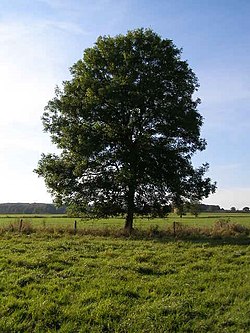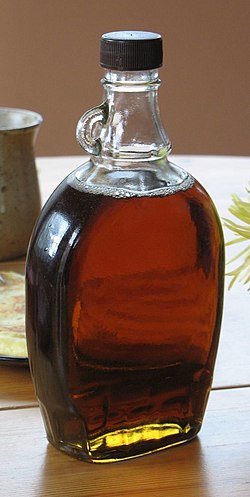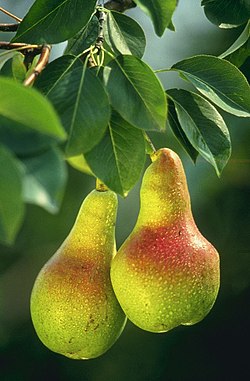Portal:Trees Source: en.wikipedia.org/wiki/Portal:Trees
The Trees Portal

In botany, a tree is a perennial plant with an elongated stem, or trunk, usually supporting branches and leaves. In some usages, the definition of a tree may be narrower, e.g., including only woody plants with secondary growth, only plants that are usable as lumber, or only plants above a specified height. Wider definitions include taller palms, tree ferns, bananas, and bamboos.
Trees are not a monophyletic taxonomic group but consist of a wide variety of plant species that have independently evolved a trunk and branches as a way to tower above other plants to compete for sunlight. The majority of tree species are angiosperms or hardwoods; of the rest, many are gymnosperms or softwoods. Trees tend to be long-lived, some trees reaching several thousand years old. Trees evolved around 400 million years ago, and it is estimated that there are around three trillion mature trees in the world currently.
A tree typically has many secondary branches supported clear of the ground by the trunk, which typically contains woody tissue for strength, and vascular tissue to carry materials from one part of the tree to another. For most trees the trunk is surrounded by a layer of bark which serves as a protective barrier. Below the ground, the roots branch and spread out widely; they serve to anchor the tree and extract moisture and nutrients from the soil. Above ground, the branches divide into smaller branches and shoots. The shoots typically bear leaves, which capture light energy and convert it into sugars by photosynthesis, providing the food for the tree's growth and development.
Trees usually reproduce using seeds. Flowering plants have their seeds inside fruits, while conifers carry their seeds in cones, and tree ferns produce spores instead.
Trees play a significant role in reducing erosion and moderating the climate. They remove carbon dioxide from the atmosphere and store large quantities of carbon in their tissues. Trees and forests provide a habitat for many species of animals and plants. Tropical rainforests are among the most biodiverse habitats in the world. Trees provide shade and shelter, timber for construction, fuel for cooking and heating, and fruit for food as well as having many other uses. In much of the world, forests are shrinking as trees are cleared to increase the amount of land available for agriculture. Because of their longevity and usefulness, trees have always been revered, with sacred groves in various cultures, and they play a role in many of the world's mythologies. (Full article...)
Maple syrup is a sweet syrup made from the sap of maple trees. In cold climates, these trees store starch in their trunks and roots before winter; the starch is then converted to sugar that rises in the sap in late winter and early spring. Maple trees are tapped by drilling holes into their trunks and collecting the sap, which is heated to evaporate much of the water, leaving the concentrated syrup.
Maple syrup was first made by the Indigenous peoples of Northeastern North America. The practice was adopted by European settlers, who gradually changed production methods. Technological improvements in the 1970s further refined syrup processing. Almost all of the world's maple syrup is produced in Canada and the United States. (Full article...)
Did you know? -
- ... that President Bill Clinton said he would personally pay the bill to keep the National Christmas Tree (pictured) lit during the government shutdown resulting from disagreements on the 1996 federal budget?
- ... that global precedence is the tendency to see the forest, and not the trees?
- ... that the mistletoe species Amyema congener of eastern Australia can grow on non-native peach, plum and pear trees?
- ... that foliage from the Australian rainforest tree Grevillea baileyana was used in the floral arrangements handed to medal winners at the 2000 Summer Olympics in Sydney?
- ... that most of the habitat of the vulnerable tree Eucalyptus benthamii has disappeared under Warragamba Dam or been cleared?
- ... that the inspiration for the Paustian House in Copenhagen came to architect Jørn Utzon while he was walking through a forest of beech trees?
- ... that Washington was the second largest tree of its kind until its collapse in 2005?
Selected article -
Pears are fruits produced and consumed around the world, growing on a tree and are harvested in late summer into mid-autumn. The pear tree and shrub are a species of genus Pyrus /ˈpaɪrəs/, in the family Rosaceae, bearing the pomaceous fruit of the same name. Several species of pears are valued for their edible fruit and juices, while others are cultivated as trees.
The tree is medium-sized and native to coastal and mildly temperate regions of Europe, North Africa, and Asia. Pear wood is one of the preferred materials in the manufacture of high-quality woodwind instruments and furniture. (Full article...)
General images
Selected lists
Subcategories
Related portals
Associated Wikimedia
The following Wikimedia Foundation sister projects provide more on this subject:
-
Commons
Free media repository -
Wikibooks
Free textbooks and manuals -
Wikidata
Free knowledge base -
Wikinews
Free-content news -
Wikiquote
Collection of quotations -
Wikisource
Free-content library -
Wikispecies
Directory of species -
Wikiversity
Free learning tools -
Wiktionary
Dictionary and thesaurus

















































































